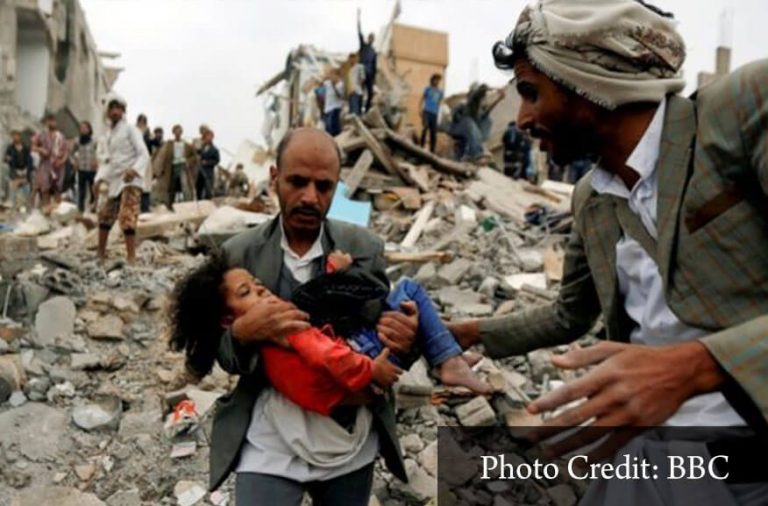Historical Perspective of Foreign Involvement in the Yemeni Crisis


Foreign Involvement in the Yemeni Crisis
In 2011, chaos broke out in Yemen, worsening the severe conditions of the country, making it the world’s worst humanitarian crisis, as considered by the United Nations of Geneva (United Nations of Geneva, 2018). According to the Human Rights Watch, a non-profit, non-government affiliated rights advocacy organization, Yemen is a society of hardship with continuous internal conflicts such as war, succession, famine, and disease outbreaks, namely cholera, endangering the wellbeing of Yemen’s people (Roth, 2019). The ongoing conflict became a Civil War, a devastating moment in Yemeni people’s life. The United States (U.S.) has played a significant role in aiding Yemen, especially by providing weapons for the war, questionably making the situation more intense. According to the Brookings Institution, an American non-profit research group, tensions rose between the Houthis and Loyalists during President Abdrabah Mansour’s leadership in 2011, resulting to another split for the first time after their 1990 reunification. The climax of the worsening tensions paved a road into the Houthis overthrowing the Loyalist Northern Yemeni government in 2014, and Abdrabah was forced to flee in 2015 (Riedel, 2017). The situation flared tensions in Yemen, leading to an armed coalition. Nevertheless, these historical sectionalism conflicts have not been diffused in the past unless a foreign governing body intervened via military force; therefore, it is suggested that to improve the internal conflicts in Yemen, foreign involvement must play a more significant role into the conflict itself. This paper suggests that while the United States and Saudi Arabia were involved in the buildup of the destructive disputes in Yemen, they cannot be blamed for the escalation of the internal Yemeni conflicts.
According to the International Observatory of Human Rights (IOHR), a non-profit organization focused on bringing human rights violations to the surface, the Houthis branched off from typical Yemeni society during the Umayyad period in 740AD, due to religious tensions between the Sunni and Shia Muslims; the internal issues of Yemen kept bubbling for the next 1,200 years. (Pynes-Jones, 2018). According to Bilal Ahmed, a student and activist at Rutgers University who spent time in Yemen, claims that both Yemeni states dealt with sectionalism issues, bringing up tension and the clashing of ideas leading to more impactful clashes among the people in Yemen (Ahmed, 2012). North Yemen became a republic in 1962, officially known as the Yemen Arab Republic (YAR); however, it was not until November 30, 1967 that the British Empire withdrew from what became the state of South Yemen, later officially known as the People’s Democratic Republic of Yemen (PDRY). In 1972, the North and South went into a two-year period of a civil war but got back together in 1990 after hefty damages on both sides following the war. Wi

th sectionalism issues already deeply engraved into Yemen’s society, it is a major stretch to assign blame to the United States and Saudi Arabia for the conflicts in Yemen. Additionally, Saudi Arabia’s involvement in Yemen has proved to diffuse the conflict in the past. According to the League of Arab States, a regional and voluntary organization of Arab speaking states, they stepped in and resolved the war with ceasefires and compromises after eight years of continuous fighting occurred in Yemen, and as they intervened, they declared the unification of Yemen was soon to occur in 1970 (Boyle, 2015). Despite being unified, due to different beliefs, the PDRY seceded from the YAR again after feeling oppressed. In May of 1990, a harsh Yemeni war broke out again between the two Republics, resulting in another Arab League intervention to reunify Yemen officially, just two months later, to become the Republic of Yemen in 1990 (Riedel, 2017). However, Yemen has gone into another civil war as it plays as an armed conflict between the Houthi Rebels and Yemeni government supported by Saudi Arabia’s coalition, with Yemeni citizens caught in the middle. While Yemen has a patterned history of sectionalism, the previous reunifications forced by the Arab League represents the constant need for foreign intervention to assuage conflicts.
With weapons being the leading cause of deaths taking a toll on Yemen’s population, there is an imperative need for the U.S. to stop sending military aid to the coalition led by the Kingdom of Saudi Arabia (KSA). According to the National Review, a non-profit magazine organization, by the end of the Obama administration, more than 4,125 Yemeni civilians were killed with sixty percent of them being the victims of airstrikes (Safi, 2018). Since the Obama era, the U.S. has provided the KSA with the majority of these following arms: armored vehicles, missile-defense systems, bombs, F-15 fighter jets, and missiles; keeping Saudi Arabia’s position since 1990 as the largest customer of American weapons, according to the Stockholm International Peace Research Institute, a nonprofit organization (Stockholm International peace Research Institute, 2017). Trevor Thrall, a Cato Institute scholar and International Affairs professor at George Mason University and a critic of U.S. involvement in the war, writes that “by supporting Saudi Arabia’s military action, we are a party to serious war crimes and are indirectly at fault for the devastating humanitarian crisis the people of Yemen now face” (Thrall, 2016). As represented with Thrall’s quote and the ever-growing statistics of the death rate of Yemeni people impacted by U.S. aided weaponry, it is imperative to put an end to the unethical aid of the U.S. to the KSA with arms, worsening the Saudi-led coalition with intentions to preserve the country of Yemen.
In a statement released directly by the White House, NSC Spokesperson Bernadette Meehan on the situation in Yemen asserted, “We strongly urge the Houthis to halt immediately their destabilizing military actions and return to negotiations as part of the political dialogue” (Statement by NSC Spokesperson Bernadette Meehan on the Situation in Yemen, 2015). The Yemeni cycle of conflicts is independent from the United States and Saudi Arabia since they’ve had a prevalent issue of sectionalism shown through the two previous civil wars, resulting in a forced alliance from the Arab League of Nations both times. Their internal conflicts have hefty consequences on the already deteriorating country. As of 2019, the United Nations Office for the Coordination of Humanitarian Affairs, non-profit organization specializing with international responses to complex emergencies and natural disasters, reported that 20 million Yemeni suffer from lack of food, 17.8 million from a lack of water, and 19.7 million from a lack of proper healthcare (Dwyer, 2017). While the U.S. and Saudi are meddling within the conflict, the Houthi rebels and Yemeni Loyalists are more responsible for the escalation of Yemen’s overall situation. The history of Yemen is important to consider as it has shaped the current circumstances of the humanitarian crisis and gives insight on the civil war altogether.
References
Ahmed, B. (2012, April 18). How the north-south relationship in Yemen is changing. Retrieved from https://arabist.net/blog/2012/4/18/how-the-north-south-relationship-in-yemen-is-changing.html.
Boyle, C. (2015, March 28). Ousted Yemeni president backs Saudi airstrikes on Houthi militants. Retrieved from https://www.latimes.com/world/middleeast/la-fg-egypt-president-backs-joint-arab-military-force-20150328-story.html.
Dwyer, C. (2017, November 16). With 20 Million Yemenis in need, Aid Groups say ‘clock is ticking’ to end blockade. Retrieved from http://www.npr.org/sections/thetwo-way/2017/11/16/564595973/with-20-million-yemenis-in-need-aid-groups-say-clock-is-ticking-to-end-blockade.
Kelemen, M. (2019, August 29). The U.S. and the war in Yemen. Retrieved from https://www.npr.org/2019/08/29/755323036/the-u-s-and-the-war-in-yemen
Stockholm International Peace Institution. (2017, May 9). Military expenditure. Retrieved from https://www.sipri.org/research/armament-and-disarmament/arms-and-military-expenditure/military-expenditure.
Pyne-Jones, L. (2018, July 28). Houthi human rights violations in Yemen. Retrieved from https://observatoryihr.org/priority_posts/houthi-human-rights-violations-in-yemen/.
Riedel, B. (2018, October 22). A brief history of America’s troubled relationship with Yemen. Retrieved from https://www.brookings.edu/blog/order-from-chaos/2018/10/22/a-brief-history-of-americas-troubled-relationship-with-yemen/.
Roth, K. (2019, January 17). World Report 2019: Rights trends in Yemen. Retrieved from https://www.hrw.org/world-report/2019/country-chapters/yemen.
Safi, M. (2018, November 30). Understanding U.S. involvement in Yemen’s ‘forgotten war’. Retrieved from https://www.nationalreview.com/2018/11/yemen-civil-war-american-involvement-under-increasing-scrutiny/.
Shamdasani, R. (2018, November 10). Bachelet urges States with the power and influence to end starvation, killing of civilians in Yemen. Retrieved from https://www.ohchr.org/EN/NewsEvents/Pages/DisplayNews.aspx?NewsID=23855&LangID=E.
Sharp, J. M. (2019, September 17). Yemen: civil war and regional intervention. Retrieved from https://fas.org/sgp/crs/mideast/R43960.pdf.
Statement by NSC Spokesperson Bernadette Meehan on the Situation in Yemen. (2015, March 25). Retrieved from https://obamawhitehouse.archives.gov/the-press-office/2015/03/25/statement-nsc-spokesperson-bernadette-meehan-situation-yemen
Thrall, T. A. (2016, February 17). The U.S. should stop supporting the war in Yemen. Retrieved from https://www.cato.org/publications/commentary/us-should-stop-supporting-war-yemen.
United Nations Office of Geneva. (2018, April 3). UNOG – The United Nations Office at Geneva. Retrieved from https://www.unog.ch/unog/website/news_media.nsf/(httpNewsByYear_en)/27F6CCAD7178F3E9C1258264003311FA?OpenDocument.
United States Department of State. (2018, August 31). U.S. Relations with Yemen. Retrieved from https://www.state.gov/u-s-relations-with-yemen/

